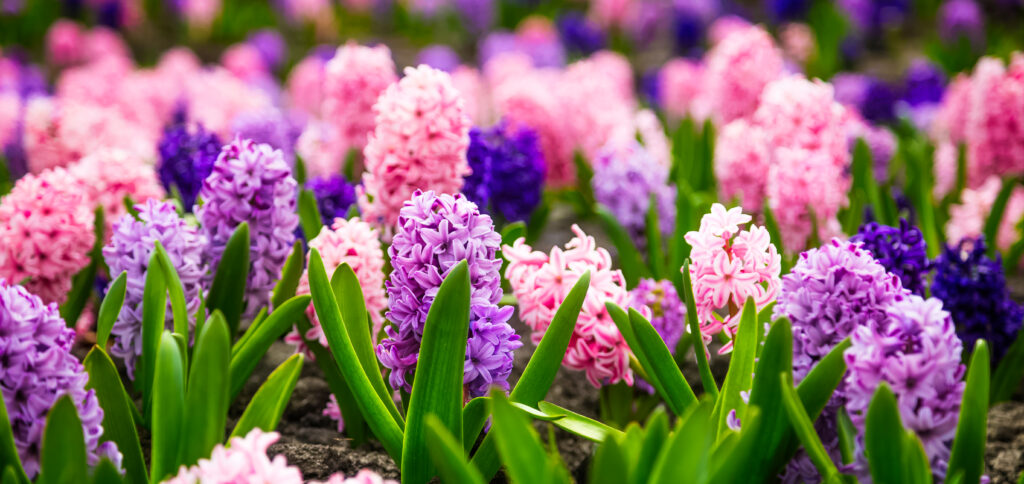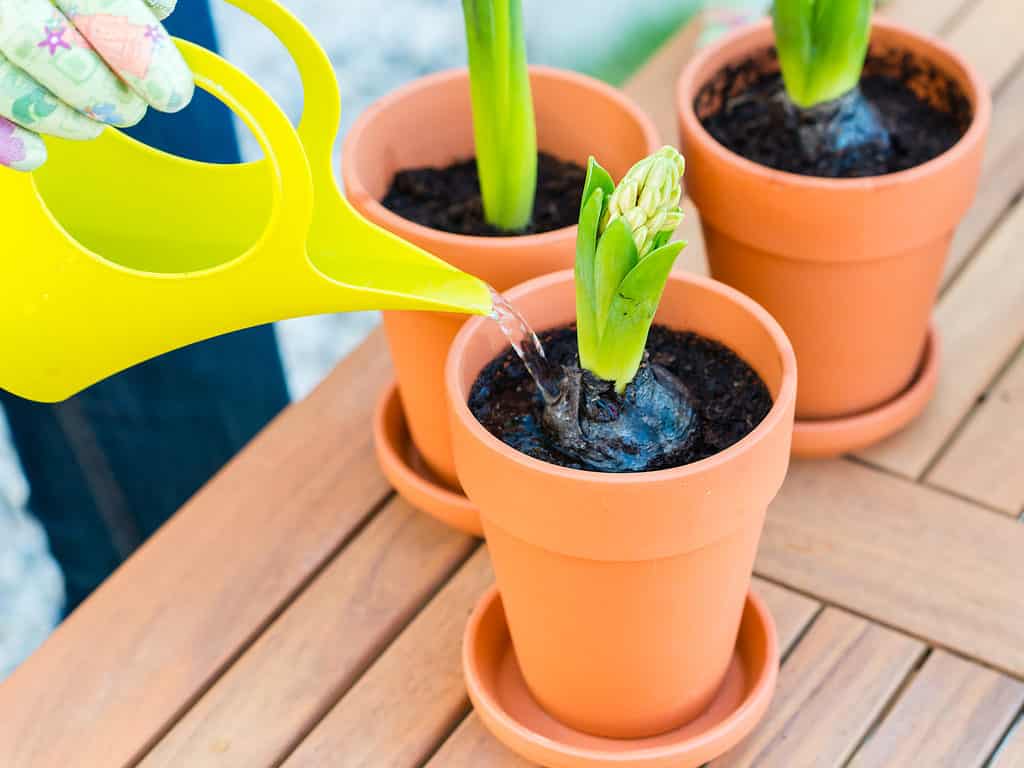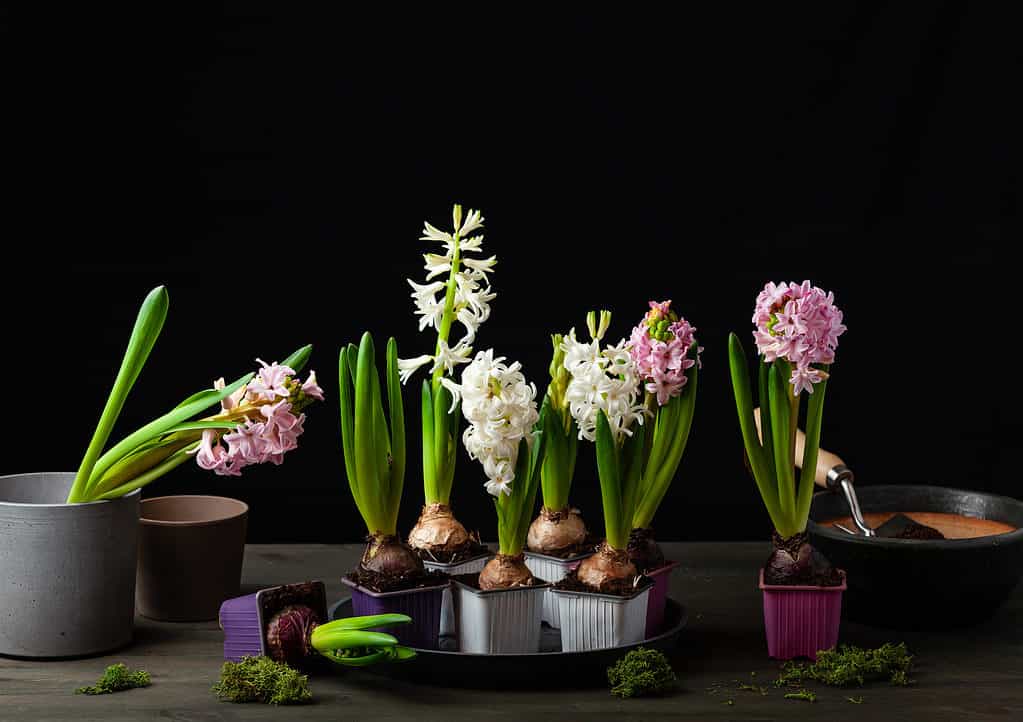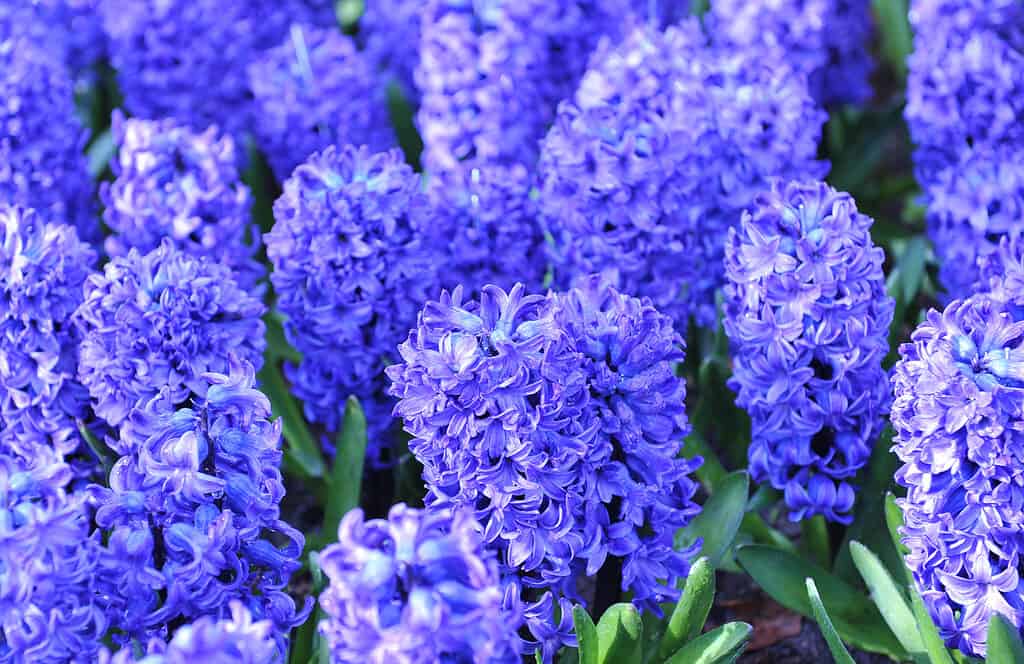If you’ve been searching for a cold-hardy spring flower that is easy to care for throughout the year, then hyacinths might be right for you. Grown all over the world for their extremely fragrant and colorful flowers, hyacinth bulbs are low-maintenance, widely available for purchase, and rewarding to grow. In this guide, we’ll explain a little bit about where these plants come from. We’ll also discuss how to care for them in your own home, whether in pots or in the garden bed.
| Botanical Name | Hyacinthus orientalis, Hyacinthus sp. |
| Popular Options | Blue and purple cultivars are most popular, e.g. Delft Blue, Blue Jacket, Aida. |
| Sunlight | Full sun, 6-8 hours per day. |
| Water | Keep soil moist throughout growing season. Water directly after planting. Taper off watering toward end of season. |
| Soil | Well-draining, rich in organic material. |
| Hardiness | Grown as perennial. Winter hardy down to USDA Zone 3. May vary depending on chosen cultivar. |
| Beginner Friendly? | Yes, very low-maintenance. |
| Special Care? | Yes. Bulbs must be cold stratified as part of life cycle. |

Through breeding of
Hyacinthus orientalisfor the garden many colorful and hardy cultivars have become widely available.
©Kateryna Mashkevych/Shutterstock.com
What Are Hyacinth Bulbs?
When considering adding an unfamiliar plant to the garden, it can be helpful to first learn a bit about its morphology and where it comes from.
Most garden-variety hyacinths are descended from a single wild species, Hyacinthus orientalis, which is a member of the asparagus family that is native across Eurasia, the Mediterranean, and southern Turkey. In the wild, hyacinths produce primarily pale blue to purple flowers. However, the intentional breeding of H. orientalis for the garden has resulted in many colorful and hardy cultivars whose bulbs are now available at garden centers all across the world.
What Is a Bulb?
You may already be familiar with the term “bulb”, but did you know that it is often used incorrectly? Many people use the term to describe just about any flowering plant that emerges from a dense, dormant root-like structure at the beginning of the growing season. Although structures such as tubers, corms, and rhizomes perform similar functions and may in some cases be mistaken for bulbs, they are all specialized in their own way. The distinction lies in the ways in which each one stores its nutrients and produces its new growth.
Hyacinths are considered true bulbs. Over the course of the growing season, the plant stores nutrients underground in a specialized set of fleshy leaves, called scales, that surround a central, modified flower bud. This strategy offers the plant food security in the case of emergency or unexpected die-off. It allows it to rest underground throughout the winter, protected from the weather above. In the spring, the plant re-emerges from its dormant state within its bulb and begins producing for the next year.

Hyacinths are considered true bulbs used to store nutrients which provide each plant with food security and protection.
©iStock.com/bubutu-
Growth Characteristics
When planted in the autumn, these bulbs will awaken from dormancy in the spring. They will produce colorful, exceptionally fragrant blooms amid slender, green, sword-shaped foliage. Most commonly, each bulb produces a single raceme, which is a long-stalked cluster of flowers, from its center. If a single flower cluster sounds underwhelming, these racemes can bear up to 40 small flowers each, all densely packed onto stalks that measure on average only 12 inches long. The actual number of flowers, of course, depends largely on the cultivar you have selected. Some cultivars of the multiflora type can even produce multiple racemes at a time! These sweetly fragrant flowers are also strong attractants of pollinators such as bees.
While popularly cut for use in bouquets or for scenting home spaces, it is important to note that all parts of the hyacinth plant are poisonous to humans and pets. Ingestion of any of its parts in large enough quantities can cause skin rashes, excess salivation, vomiting, diarrhea, and stomach cramping. It is possible for the flowers’ fragrance to aggravate asthma symptoms and cause irritation of the nose. Wearing gloves when handling hyacinth bulbs is also a good idea. It is common for many people to experience contact dermatitis.

Each hyacinth bulb typically produces a single raceme, which is a long-stalked cluster of flowers, from its center.
©iStock.com/OlgaMiltsova
How to Care For Hyacinth Bulbs
Whether out in the garden bed or in a container on a sunny porch, hyacinths are a great low-maintenance option to add color and aroma to any space throughout the growing season. If you’re interested in giving hyacinths a shot, there are some important aspects of their care that you should familiarize yourself with ahead of time.
Planting
Hardy down to USDA Zone 3, hyacinths naturally require an extended period of cold weather as part of their life cycle. In growing zones where temperatures fall below 45 degrees Fahrenheit, hyacinths can be dug into the garden bed about mid-fall. They should be mulched for insulation and then watered thoroughly at this point to encourage root growth. From here, your bulbs will remain dormant throughout the colder months of the year. They are in preparation for the upcoming spring growing season.
In warmer areas that do not experience cold fall and winter temperatures, bulbs must be cold stratified, or chilled, at temperatures between 35 and 48 degrees Fahrenheit for a period of 12-13 weeks before they are planted in order to mimic the seasonal conditions of their native range. This cold period signals the arrival of winter to the dormant bulb. The bulbs respond by beginning to develop embryonic leaves and flowers that will emerge in the spring. Your bulbs will need this cold stratification every year, regardless of where they are planted. This means you will need to dig up bulbs that are planted directly in the ground.
Planting Hyacinth Bulbs in the Garden
When selecting an outdoor site, consider planting your hyacinths in groups, 4-6 inches apart, so that they can hold each other up rather than require staking. Bulbs should be planted about 4 inches deep in your garden bed. A couple of extra inches of depth can be added for additional insulation in zones where particularly cold winter temperatures are expected.
Planting Hyacinth Bulbs in Containers
When planting in a container, the following method should be used:
- Lay down a layer of potting soil approximately 2 inches deep across the bottom of a shallow pot.
- Place your hyacinth bulbs on top of this layer with their pointed end facing up. You can add as many bulbs as you can fit in your pot. Ensure they do not touch each other or the sides of the pot.
- Fill in the remaining space with potting soil, ensuring that the pointed ends of the bulbs remain uncovered.
- Gently firm the soil and water your newly planted bulbs to encourage root growth.
Light Requirements
Like most bulbous spring flowers, hyacinths require full sun over the course of their growing season. This ensures that they can muster up the energy to not only produce flowers (and seed if desired), but also to store energy for dormancy and re-growth the following spring.
Water
Your hyacinth’s soil should be kept moist, especially during spring growth and immediately after planting in order to encourage dormant bulbs to put out roots in their new soil. As the growing season approaches its end, it is important to gradually reduce the amount of water given to your plants. Less water will allow them to properly enter their dormant phase.
Soil Conditions
Hyacinths do best in soils that are well-draining and rich in organic material, such as compost or well-rotted manure. These soils should be easy to keep moist with proper monitoring. Remember not to let your plant’s soil dry out completely during the growing season.

Your hyacinth’s soil should be kept moist, especially during spring growth and immediately after planting to encourage dormant bulbs to root.
©Sergey V Kalyakin/Shutterstock.com
How to Propagate Hyacinth Bulbs
Hyacinth bulbs can be propagated at home. Although the process is rewarding, it is also quite slow. The process can take several years of care before your new bulbs reach flowering age. There are faster, more technically involved methods of propagation such as chipping and scooping, but we’ve listed the simpler methods below:
Propagation By Seed
If your hyacinth flowers are left intact throughout the growing season, you can collect the seeds that they produce and use these as starts for new bulbs. These new bulbs, however, will take several years to begin producing flowers. There is no guarantee that their flowers will resemble those of their parents.
If you choose to take this route, spread your seeds across a tray of potting soil and then cover them with a thin layer of sifted compost and fine, clean sand. At this point, the entire container should be placed in a greenhouse, cold frame, or other such unheated shelter and kept moist until the following year. Once your new hyacinth plants have germinated and begun establishing themselves, it can take several more years for them to reach the stage of their lives during which they will produce flowers.
Propagation By Division
At the end of the growing season, when it is time to dig up your bulbs for storage, carefully examine the roots of your bulbs. It is likely that you will notice miniature bulbs clinging to the base of the mature bulb. These genetic copies of the mature bulb are called offsets. They can be carefully separated from the parent plant for planting. Although it will still take a number of years, plants that arise from these new bulbs will be true to type. They will produce flowers that resemble those of the parent bulb.
The photo featured at the top of this post is © Sergey V Kalyakin/Shutterstock.com
Sources
- Missouri Botanical Garden / Accessed February 12, 2023
- NC State Extension / Accessed February 12, 2023
- Wisdom, M. M., Richardson, M. D., Karcher, D. E., Steinkraus, D. C., & McDonald, G. V. (2019). Flowering Persistence and Pollinator Attraction of Early-spring Bulbs in Warm-season Lawns, HortScience horts, 54(10), 1853-1859 / Accessed February 12, 2023
- Gardening Solutions - University of Florida Institute of Food and Agricultural Sciences / Accessed February 12, 2023
- K. WILSON, J. N. HONEY, Root Contraction in Hyacinthus orientalis, Annals of Botany, Volume 30, Issue 1, January 1966, Pages 48–61 / Accessed February 12, 2023
- University of Florida Institute of Food and Agricultural Sciences / Accessed February 12, 2023
- Toronto Master Gardeners / Accessed February 12, 2023
Thank you for reading! Have some feedback for us? Contact the AZ Animals editorial team.







